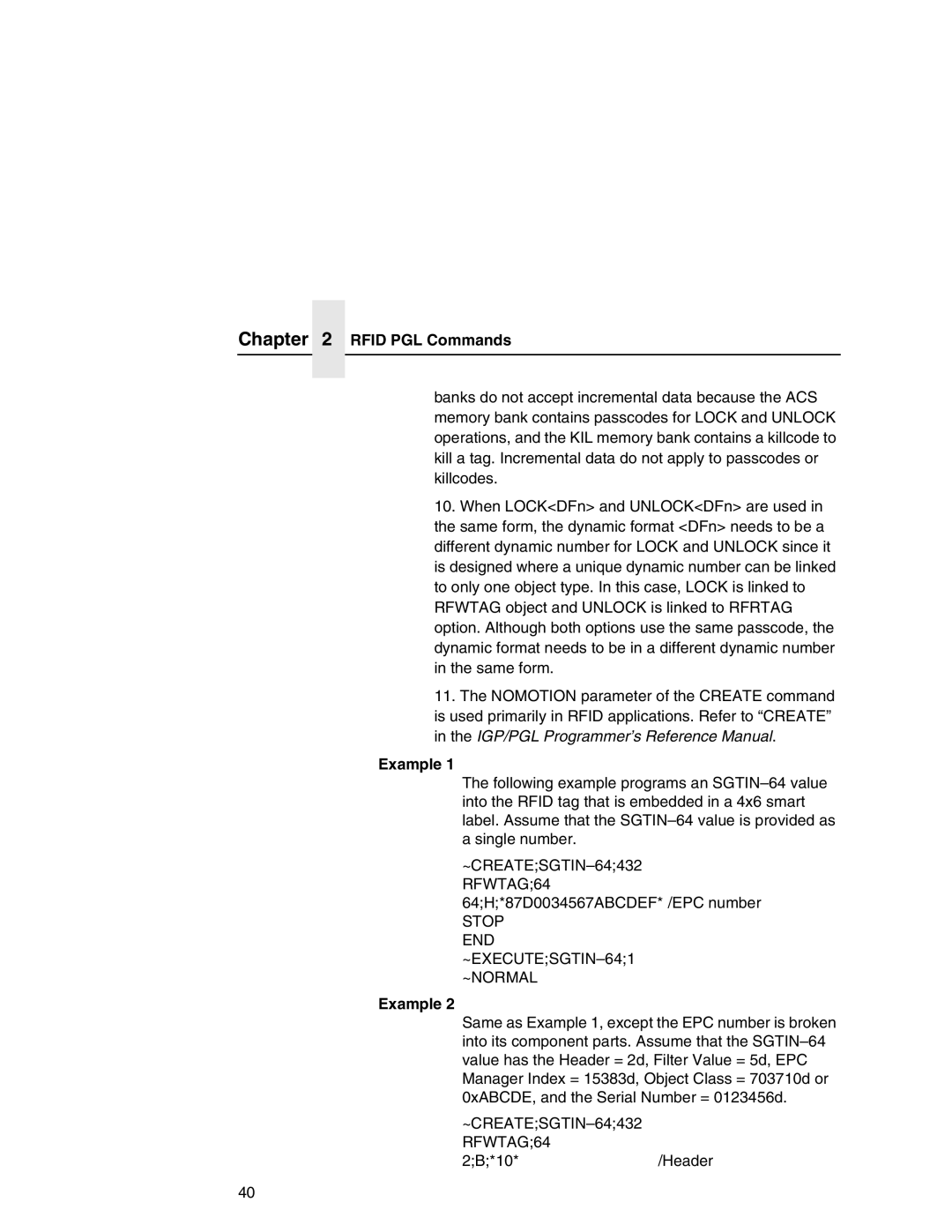Rfid Labeling Reference Manual
Page
Rfid Labeling Reference Manual
Trademark Acknowledgements
Table of Contents
MP2 Rfid
Table of Contents
Table of Contents
Rfid Smart Label Application Reference Notes
Overview
Overview
What To Expect When Running Your Rfid Application
Factors Affecting Smart Label Performance
Overstruck Smart Labels
Factors Affecting Smart Label Performance
Smart Label Characteristics
What To Expect When Running Your Rfid Application
Supported Tag Types
General Tag Type
Technology Tag Class
Smart Label Characteristics
Label Size
How It Works
How Printronix Makes It Easy
Transitioning From UCC/GTIN Applications
Hardware/Infrastructure Considerations
How It Works
Printronix Professional Services
How To Order More Smart Labels
Contact Information
Printronix Customer Support Center
Corporate Offices
Corporate Offices
Useful Industry Web Links
Smart Label Development
Rfid Control Menu
Rfid Control Menu
Cont. from previous
Cust Early Write Custom Run Cal
Rfid Control Menu Items
Rfid Reader
Tag Type
Rfid Control Menu Items
Page
Page
Page
Error Handling
Max Retry Error
Label Retry
Tag Write Cnt
Failed Tag Cnt
Tag Void Cnt
Tag Read Cnt
Clear Tag Stat
Overstrike Style
Admin User Menu Items
Read Tag
Read Tag&Eject
PreErase Class 0+
Admin User Menu Items
Auto Retry
Custom Tag
Custom Write Pwr
Custom Read Pwr
Custom Tag Len
Custom Tag Class
Custom Rd Tries
Custom Min Power
Custom Run Cal
Custom Tag Pos
Custom Start Pos
Custom Max Power
Requesting An Rfid Report
EPC Mgr Report
Non-RFID Warning
Rfid PGL Commands
Format RFWTAGLOCKnformatsizemem bank Bit Field+
Stop
LOCKnformat
Rfid PGL Commands
DF command in the Execute
IDF command in the Execute
Step and startdata parameters using
IDF command in the Execute mode
Repeated before it is incremented. The default repeat
Optional incremental reset count parameter to
Printed before it is reset to the starting value. By
Default, there is no reset count. The reset count
Rfwtag
~CREATESGTIN-64432 RFWTAG64
Example
Stop END ~EXECUTESGTIN-641 ~NORMAL
SGTIN-64 ~CREATESGTIN-64432 RFWTAG64
Stop Alpha
Stop END ~EXECUTESGTIN-64
~DF4*ABCDE
Stop END ~EXECUTESGTIN-64ICNT1500 ~NORMAL
~CREATESGTIN-96432 RFWTAG96
Stop END ~EXECUTESGTIN-961 ~NORMAL
~CREATESGTIN216
RFWTAG96EPC
Stop Barcode
~CREATESGTIN432
RFWTAGLOCKDF6D96EPC
END ~EXECUTESGTINFCNT3
Format RFRTAGUNLOCKnformatsizemem bank Bit Field+
Stop Rfrtag
UNLOCKnformat
Indicate dynamic data
Field to store the read
Result. Replace n with a
Number ranging from 1 to
Format
Stop RFRTAG64
Verify
Format VERIFYfieldformatDASCIIheaderD DASCIITrailerD
ASCIIheader
ASCIITrailer
Example
~CREATEVERIFY432NOMOTION RFRTAG64
Stop RFRTAG64 64DF2H
END ~EXECUTEVERIFY1 ~NORMAL
~CREATEREADONLY432 RFRTAG64
Write Tag
Rfid PGL Commands Example
Format
Write Tag
Rfwrite
HEX
Lock
Read Tag
Format RDIposition,length,format
RDI
Position
Read Tag
Rfid PPI/ZGL Commands
Format RT x, start, length, hex, retries, motion, reserved
Rfid PPI/ZGL Commands
Comments
Start
Retries
Write or Read Rfid Format
Write or Read Rfid Format
Format RFa,b,c,d
Define EPC Data Structure
Calibrate Rfid Transponder Position
Format HRa,b
Rfid Setup
Enable Rfid Motion
Specify Rfid Retries for a Block
Set Rfid Tag Password
Format RZa
Host Verification
PPI/ZGL EPC Programming Examples
Host Verification
Format HVx,y,ASCII
FO100,100A0N,60,60FN1FS //Print tag data in FN1
Escrk 1,a,b,D16,c.c Escrk 1,a,b,D24,c.c Rfid Write
Rfid PPI/STGL Commands
PPI/ZGL EPC Programming Examples
Return Status Port
Return Status Port
Tools List
Software Migration Tools SMT
Tools List
Page
Selecting The Tools
Selecting The Tools
Error Messages
Error Messages
Control Panel Error Messages Explanation Solution
Rfid MAX Retry
Rfid TAG ERR
Rfid TAG Failed
Rfid Unlock CMD
Troubleshooting
Troubleshooting
Troubleshooting the Rfid Encoder Symptom Solution
Setup Guide
MP2 Rfid
New Coupler System
Adjusting The Coupler Position
New Coupler System
Bit And 96 Bit EPC Data Formats
Class 1 Gen
Gen
Class 0+, Class Zuma, and Class
Request from Result Comment
PGL EPC Format Handling Selected Size of Data Based on
Length Program
64 bit Pad 0s on right for 64 bit = 64 bit
When 64 Bit Data Is Sent To a 96 Bit Tag PGL
Moving From 64 Bit Tags To 96 Bit Tags
Example
Moving From 64 Bit Tags To 96 Bit Tags
When 64 Bit Data Is Sent To a 96 Bit Tag ZGL
When 64 Bit Data Is Sent To a 96 Bit Tag ZGL
~NORMAL ~CREATETEST1216 RFWTAG64
Multiple Read/Write Commands On One Label
~NORMAL ~CREATETEST1NOMOTION RFRTAG64
END ~EXECUTETEST1 ~NORMAL ~CREATETEST1 RFWTAG64
END ~EXECUTETEST1 ~NORMAL
Verify Command is not Rfid Specific
Verify Command is not Rfid Specific
Splitting the EPC
Customer Scenario
Simplest Solution
Splitting the EPC
Tag Profiler
Using The Advanced Rfid Calibration
Tag Profiler
Using The Advanced Rfid Calibration
Custom Tag Configurator
Auto Inlay Locater
Page
178424-001

